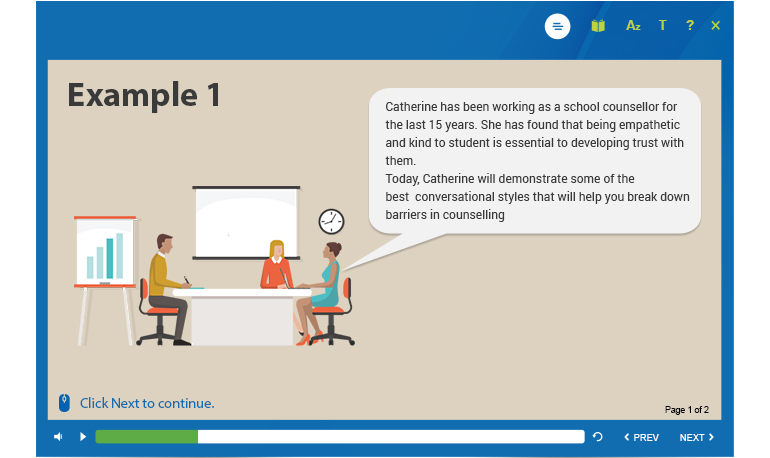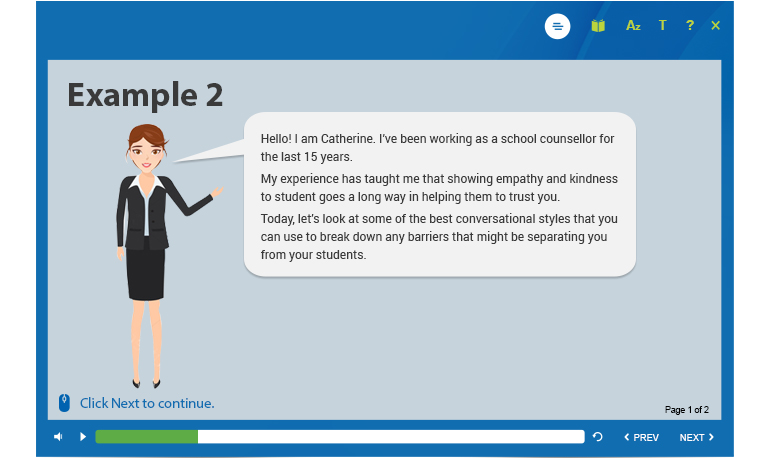Here are Two Sample Course Screens


Which sample do you find more effective? For most of us, it is easier to relate to the second example. Why? Because it is in harmony with the personalization principle—it uses a conversational style, has an effective on-screen coach, and a visible author.
Let’s look at the significance of the second aspect of the personalization principle—using effective on-screen coaches or pedagogical agents.
Pedagogical Agents
Pedagogical agents are virtual life-like characters used in online learning environments who help guide the learning processes. These on-screen coaches serve various instructional goals. They:
- Act as instructors or motivators
- Interact with learners
- Provide cognitive support
- Offer social enrichment to the learning experience
- Provide human-like assistance
- Reduce learner anxiety and frustration
- Act as a learning companion
- Support learning and instruction
- Guide learners
How can you represent pedagogical agents in eLearning? You can represent them visually as cartoon-like characters, as a talking-head video, or as virtual reality avatars; and represent them verbally through machine-simulated voice, human recorded voice, or printed text. You can also represent them as real people using video and human voice or artificial characters using animation and computer-generated voice.
Do Pedagogical Agents Enhance Learning?
Why should you invest time and money to incorporate pedagogical agents into your elearning? Because if you don’t, your learning outcomes will suffer.
Agents Improve Performance
In a study by Moreno, Mayer, Spires, & Lester, 2001, it was seen that students who learned by interacting with an on-screen agent generated 24 to 48 percent more solutions in transfer tests than the students who learned without an agent.
In another study (Atkinson, 2002), a group of students learned to solve proportionality word problems with the help of an on-screen agent who spoke to them, giving a step-by-step explanation for the solution. On a subsequent transfer test, these students generated 30 percent more correct solutions than the students who learned without an agent.
Hence, there is clear evidence suggesting that it is worthwhile to consider the role of animated pedagogical agents as aids to learning.
Pedagogical Agent Qualities
What makes an effective agent? Do people learn better from human-looking agents or cartoon-like agents?
Research suggests that a lifelike image is not always an essential component in an effective agent. There is not much of a difference in learning when a real character is used or a cartoon-like animated character. In addition, people learn just as well when the image of the character is present or absent, as long as they can hear the agent’s voice.
Agents Need Realistic Human-Like Behavior
Agents may not have to look real, but evidence does indicate that these agents should demonstrate human-like actions in terms of their gestures, movements, and eye-gaze. In a study by Lusk and Atkinson (2007), it was found that students learned better from an on-screen agent who used human-like locomotion, gestures, and eye-gazes rather than from an agent who was physically present but did not move, gesture, or gaze at the learner.
Hence, on-screen pedagogical agents do not need realistic human-like appearance but do need realistic human-like behavior.
Agents have to Sound Conversational
An important factor that makes the agents effective is that they have to sound conversational. Various studies show that people learn better when:
- Words are spoken rather than presented as on-screen text (modality effect)
- Words are spoken in a conversational style rather than a formal style (the personalization effect)
- Words are spoken in a human voice rather than a machine-simulated voice
Consider the Following Suggestions When Using Pedagogical Agents:
- Present the agent’s words as speech rather than text, in conversational style rather than formal style, and with human-like rather than machine-like articulation
- Use agents to provide instruction rather than for entertainment purposes
- Use some first- and second-person constructions—“I,” “we,” “me,” “my,” “you,” and/or “your”—in the script for a narration or the text for an on-screen passage to create the feeling of conversation between the course and the learner
- Do not overdo the personalization style in the script as this might distract the learner
Though pedagogical agents are constrained by programming, and cannot replace a real teacher or mentor, it is advisable to use pedagogical agents in online courses as research indicates a positive impact on learning.




